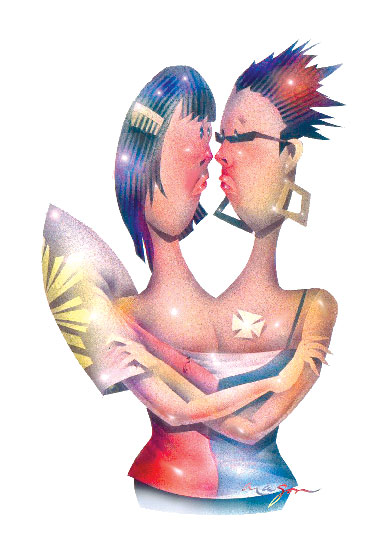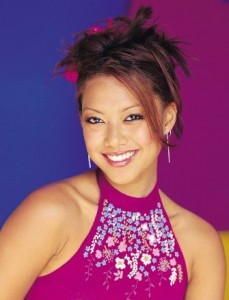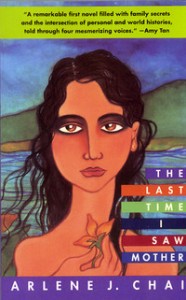
Image by: Edd Aragon
Image by: Edd AragonI started out with this great idea of writing an article about what it means to be an Australian-Filipina. It was going to be a well-researched and engaging piece with the concept of the Australian-Filipina identity neatly wrapped up and presented to you in a gift box.
Alas, this vision was too ambitious for a two-page story. If you’ve ever read up on Filipino history and how Filipinos formed their cultural identity with the 400 years of Spanish rule and another 50 years of American colonisation, you’ll know how very complex it is. Add to this the other influences from the beginning such as our Malay roots from Indonesia for example, and you get a clearer idea of the complexity involved.
Let me clarify first that when I write about an ‘Australian-Filipina’ I don’t just mean someone who has one Australian and one Filipino parent. Being an Australian-Filipina goes beyond this racial territory. It’s also about the culture, the morals, the beliefs, the values and the spirit that embody her. Any woman of Filipino heritage who calls Australia home is an Australian-Filipina.
Naturally, someone who moved from the Philippines to Australia in the last few years would embody more of the Filipino culture than someone who moved here when she was 10 years old. Again, someone who was born here of two Filipino parents would have a different experience to someone who only has one.
And let’s not forget that it isn’t just nationality or race that creates the difference. Like in any society today, a person’s education level and socio-economic status has a major influence on their identity. What suburb they grew up in, where they went to school and who their friends are can all make a difference. Someone who grew up experiencing a lot of racism will ultimately have different ideas to someone who’s been sheltered and oblivious to such a horrible experience.
–~~~~~~~~~~~~–
As you can see, it becomes crystal clear that defining an Australian-Filipina would be like defining the form of a snowflake. All snowflakes are made of ice and have six points or sides, just like all Austalian-Filipinas have the Australian andthe Filipino in them. But just as one snowflake is unique and unlike any other snowflake, so is an Australiani-Filipina. No two are ever exactly the same.
This is highlighted by the different responses I get when I ask Australian-Filipina friends about what it means to them to have these two cultures as part of their identity. I spoke to three very different Australian-Filipinas who have, or have had public identities and the responses were just as varied.
 Kate Ceberano
Kate CeberanoKate Ceberano is a well-known name in the Australian music industry. If you know it, you’ve been in Australia long enough. She’s been in the public eye for about 20 years yet somehow, her Filipino heritage has remained in the background, until now.
Raised in Melbourne by a Hawaiian-Filipino dad and a mother of Swedish/French heritage, Kate says, “I was a little confused about how I felt about it well into my twenties, so I didn’t really feel anything but Australian having been born and raised here.”
According to Kate, being Filipino wasn’t in her universe while growing up because she lived in a suburb full of migrants who were busy trying to be Australian. This all changed recently, especially after having her ?rst child and she says, “I’ve felt displaced in a sense until I had my kid and realised that I actually do have relations with a culture. I just don’t know anything about it. And in every way I actually personify all the attributes that the Filipinos are known for like music, entertainment.
“As I’ve become more interested in my roots, suddenly there’s a lot more to you that you become aware of. When you can work out where you come from you can become clearer on why you are the way you are. I know that having experienced working with music and the Filipino musicians, I can understand why music was so easy for me and I understand myself a lot better as a musician. “I’m creating more focus on my identity which is a blend, a real mixture.”

–~~~~~~~~~~~~–
 Kathleen de Leon Jones, former member of children's group Hi-5
Kathleen de Leon Jones, former member of children's group Hi-5Kathleen de Leon Jones former member of children’s group Hi-5 was only a year old when her family migrated from the Philippines to Sydney. Being a full-blooded Filipino who’s lived in Australia all her life, the two cultures in her identity are well integrated.
“My parents were very happy for us to explore where we were living and how we were living and because I went to a very multi-cultural school they were open to a lot more of what I brought home,” she says. “When you start discovering boys and that, it would all come in, that very Catholic and very Filipino way of living.
“Before I married Daniel it was all, ‘You can’t live together … la la la,’ that kind of thing but my parents, more so now, are very open to the cultures. Because they grew up with me being so rebellious, they’re a lot easier on my sisters. This is the thing, they were kind of strict to a certain degree but I look back and think I’m glad they were because I’m glad with the way I’ve turned out.”
When asked if the rebelliousness was because of the challenges of integrating the often-clashing Australian and Filipino cultures, Kathleen is quick to say, “They were just normal teenager stuff. Not really something related to being Filipino.”
 Arlene J. Chai is a published author who wrote the best selling novel The Last Time I Saw Mother. She’s been calling Australia home since 1985 and unlike Kate and Kathleen, was raised and educated in the Philippines. She says, “I’ve never de?ned myself in terms of my nationality. My parents are actually Chinese and even though I grew up in Manila and I was educated there, I never thought about my parents being Chinese and what I was conscious of was me as a person. So if you’re asking me what my identity is, or what I think an Australian-Filipina is, I can’t quite answer that question.
Arlene J. Chai is a published author who wrote the best selling novel The Last Time I Saw Mother. She’s been calling Australia home since 1985 and unlike Kate and Kathleen, was raised and educated in the Philippines. She says, “I’ve never de?ned myself in terms of my nationality. My parents are actually Chinese and even though I grew up in Manila and I was educated there, I never thought about my parents being Chinese and what I was conscious of was me as a person. So if you’re asking me what my identity is, or what I think an Australian-Filipina is, I can’t quite answer that question.
“National identity is not an obsession I have. It’s not something that is topmost in my mind. Maybe that’s a measure of how integrated I am with where I live. Some people may say that’s bad that I don’t remember my roots. But what are my roots? They go back so far.
“But you can’t say that I don’t remember my roots because if you read my writing it’s there. You carry it somewhere, you’re just not consciously thinking of it. What is a Filipino if not a mix of so many cultural influences?”
–~~~~~~~~~~~~–
No truer words have been said. With Australia in the cocktail, we’re ready to party. However, it’s not all rainbows and roses. Being an Australian-Filipina comes with many challenges.
The ones I faced during puberty were how to assimilate and not feel torn over whether I’m Filipino or Australian. It was confusing. I just wanted to do what all the other kids were doing, which was being teenagers, going out and having fun. But I suppose it’s understandable that my parents were extra strict with me because they’re raising their ?rst-born daughter in a foreign culture.
To be honest, I hardly remember what we fought over but I do have distinct memories of arguments over the fact that I considered myself Australian. My parents would always be quick to point out that I’m Filipino, not Australian. I’ll never forget the words I uttered many times over those years; “If you wanted me to grow up as a Filipino then you should never have brought me here to live.” Harsh words perhaps, but true. Thankfully, as an adult I feel completely at peace with the Australian-Filipino that I’ve become, as I’m sure many others do too.
So you see, individual personalities as well as positive and negative experiences alike, make for unique Australian-Filipinas. And that’s really the beauty of it.AF_logo blue